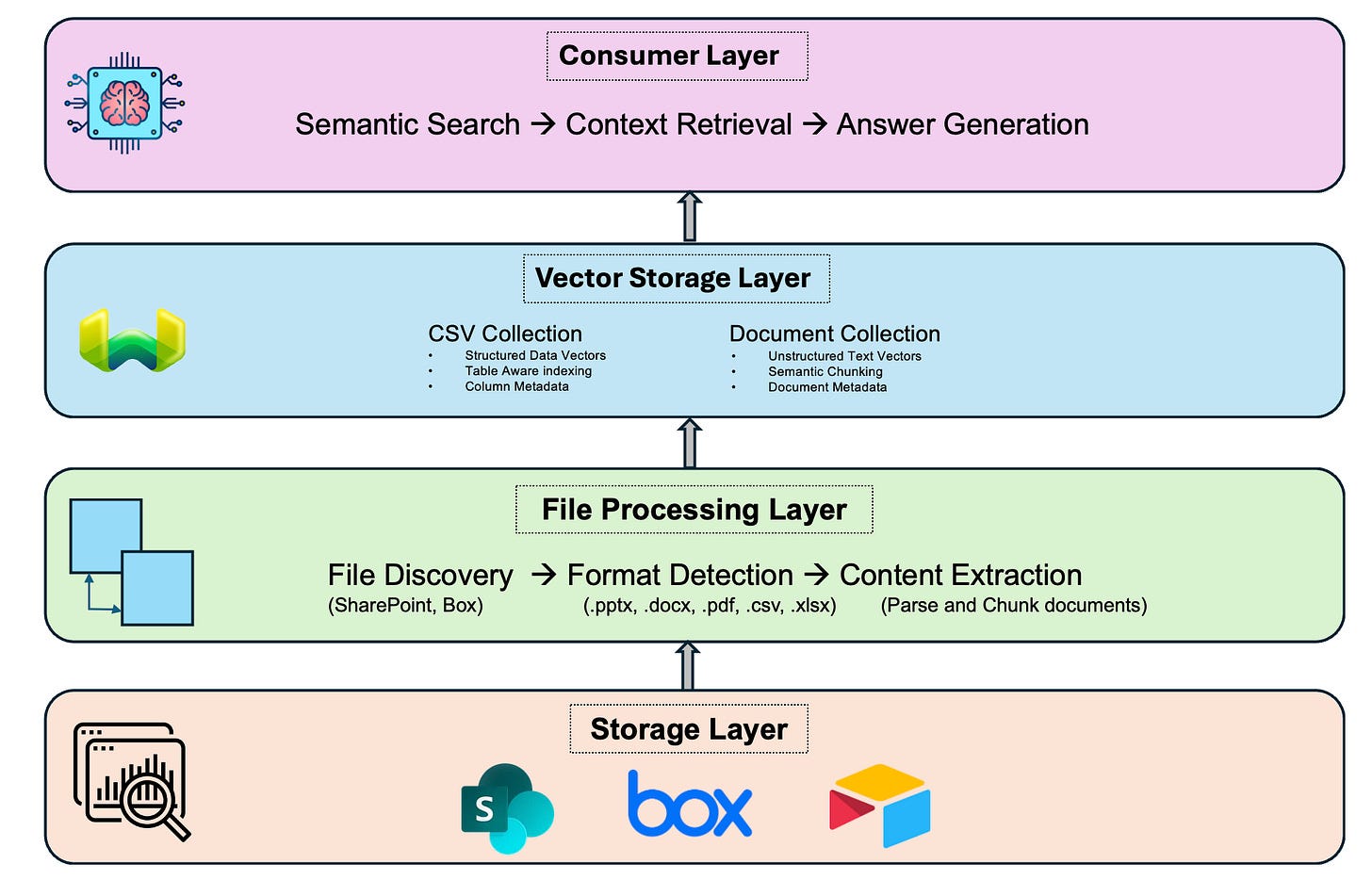Background
Global businesses face a common enemy: fragmented IT landscape. Years of acquisitions, coupled with the rush towards cloud technology, have left many with a tangled mess of systems. Different countries, different business units – each with its own way of doing things.
Traditional integration approaches, often manual and document-heavy, are notorious for their slow pace and susceptibility to errors. Discovering existing interfaces and understanding their intricacies can feel like navigating a labyrinth. The missing link? Seamless integration. Without it, data gets stuck, operations slow down, and the business can’t reach its full potential.
How many of us resonate to this problem story?
Once upon a time, there was a company called Client X. They were really good at what they did, but they had a secret problem… their data was a mess!
Imagine a huge maze of pipes and tubes, all carrying important information between different parts of the company. Some pipes were old and rusty, others were brand new, and they were all jumbled up. Sometimes the information got stuck, or went down the wrong pipe, and it caused all sorts of delays and headaches.
I bet everyone, ain’t it?
Can a gen AI enabled Global Integration Factory solve this crisis?
Client X knew they needed a better system, so they decided to build an Integration Factory. This factory would act like a clever organizer for their data, making sure everything flowed smoothly and efficiently.
But there was still a problem – how would people know which pipe to use for which information? That’s where the Gen AI Chat bot came in.
This friendly Gen AI GPT lived inside the Integration Factory and knew everything about the data pipes. Need to send sales data to the marketing team? Just ask the Gen AI GPT! It would point you to the right pipe and even give you tips on how to package the information correctly.
The GPT also had a handy map of all the existing pipes, so before building a new one, people could check if one already existed. If it didn’t, it can tell you how much time and cost is required to create a new pipe and generate quick simulation of pipe leveraging reusable pipe machinery. This saved a lot of time and effort, and made sure everyone was working with the same information.
And if a pipe ever sprung a leak (which happens sometimes!), the Integration Factory had a special alarm system that would notify the right people immediately and model scenarios to fix the pipe leak before it happens. This meant problems could be fixed quickly, before they caused too much trouble.
Thanks to their new Integration Factory and helpful GPT Chatbot, Client X was able to untangle their messy data maze and make sure information flowed smoothly throughout the company. And so, they lived happily ever after (or at least, their data did!).
Who doesn’t like a fairy tale ending?
Gen AI Chatbot Enabled Integration Factories: Ushering in a New Era
Imagine a centralized hub where a Gen AI Chatbot acts as your intelligent guide through the complexities of integration. This is the power of the Gen AI Chatbot Enabled Integration Factory. Here’s how it’s transforming the landscape:
Accelerated Interface Discovery: No more sifting through endless documentation. The Gen AI Chatbot, trained on your existing integration assets, can instantly answer questions like “What interfaces exist between our CRM and ERP systems?” or “What data points are exchanged in our supply chain integration?”. This rapid access to information drastically reduces the time spent on initial discovery.
Simplified Interface Design: The Gen AI Chatbot can assist developers in designing new interfaces. By understanding requirements articulated in natural language, it can suggest suitable interface patterns, data formats, and even generate code snippets. This empowers developers to focus on higher-level tasks, accelerating the design phase.
Streamlined Interface Building: Integration factories excel at automating repetitive tasks. With a Gen AI chat bot at its core, this automation becomes even more powerful. The chat bot can guide developers through the implementation process by simulating integration flows and generating codes, flag potential issues, and even automate testing procedures, leading to faster and more reliable deployments.
Benefits Beyond Speed
The advantages extend beyond just speed:
Democratized Integration: The intuitive nature of a chat bot interface makes integration accessible to a wider audience, including citizen integrators and business users, further accelerating the pace of innovation.
Reduced Errors: Automation and AI-powered guidance minimize the risk of human error, leading to more robust and reliable integrations.
Improved Collaboration: The centralized nature of the factory, coupled with the chat bots communication capabilities, fosters better collaboration between different teams involved in the integration process.
Gen AI Chat bot Enabled Integration Factory Solution Components
The proposed solution architecture outlined below illustrates how we can implement appropriate governance and automation to expedite interface design and deployment, ultimately driving process optimisation and efficiency.
Chat GPT component: This component streamlines integration by connecting clients and their implementation partners with expert guidance. By answering a few key questions about their specific needs (e.g., systems, data volume, use case patterns), they receive tailored recommendations, generates integration flow libraries and architecture diagrams for the optimal integration tools and strategies. It can also generate podcasts to train local teams on existing global interfaces per process area.
This personalized approach accelerates deployment, minimizes procurement costs, and reduces long-term maintenance burdens. Recommendations are automatically submitted to the integration factory governance team for review and approval, streamlining the decision-making process.
Upon approval, requestors are automatically notified and prompted to provide the necessary information for the recording the integration inventory, ensuring a smooth transition to the next stage of the process.
SAP ISA-M Global Integration Inventory Knowledge Component
This component empowers local teams to design and deploy integration quickly by promoting the reuse of existing integrations, which eliminates redundant efforts and reduces development costs. It also simplifies upgrades by allowing teams to easily estimate the complexity and cost associated with middle ware upgrades across the entire organization and provides traceability of integrations to all project documentation.
Before starting development, clients and their implementation partners submit a request for a unique Interface ID, outlining their project requirements. This component then checks for any existing, reusable interfaces, providing details if found or creating a new ID if needed. Once the Interface ID is created, the system automatically notifies the relevant teams to grant access to the development environment. The requestors then receive access details along with automated documentation templates and architecture diagrams and functional unit test scripts with automated message structures to simulate data between systems.
Rules and Governance Component
This rules and governance component ensures high-quality interfaces by overseeing their design, deployment, and adherence to standards. It streamlines incident management, a common challenge in diverse IT environments, by automatically assigning interface defects to the appropriate teams with accurate priority classifications (P1/P2). Leveraging automation and self-healing techniques, it proactively addresses design flaws, defects, and errors. Additionally, it serves as a central knowledge repository for exceptions, providing valuable insights to continuously improve the integration ecosystem.
This solution will empower organisations to:
Eliminate Redundancy: Easily search, identify, and reuse existing integrations, breaking down silos and avoiding repetitive work.Gain a Holistic View: Visualize the entire integration landscape across all business units and geographies.Accelerate Digital Transformation: Quickly assess the impact of changes by searching the integration flow repository and identify right tools and ISA-M patterns.Integration Service Level Efficiencies: Manage interfaces efficiently and resolve issues proactively.Manage Costs: Accurately estimate costs and complexities associated with upgrades and new technologies.Enhance Customer Experience: Proactively address incidents and minimize disruptions.Optimize Performance: Analyse and learn from integration patterns to prevent recurring errors.Unlock New Revenue Streams: Identify and monetize internal APIs faster by fostering a culture of co-innovation with customers and suppliers.
Do you have any other ideas?
BackgroundGlobal businesses face a common enemy: fragmented IT landscape. Years of acquisitions, coupled with the rush towards cloud technology, have left many with a tangled mess of systems. Different countries, different business units – each with its own way of doing things. Traditional integration approaches, often manual and document-heavy, are notorious for their slow pace and susceptibility to errors. Discovering existing interfaces and understanding their intricacies can feel like navigating a labyrinth. The missing link? Seamless integration. Without it, data gets stuck, operations slow down, and the business can’t reach its full potential.How many of us resonate to this problem story?Once upon a time, there was a company called Client X. They were really good at what they did, but they had a secret problem… their data was a mess!Imagine a huge maze of pipes and tubes, all carrying important information between different parts of the company. Some pipes were old and rusty, others were brand new, and they were all jumbled up. Sometimes the information got stuck, or went down the wrong pipe, and it caused all sorts of delays and headaches.I bet everyone, ain’t it?Can a gen AI enabled Global Integration Factory solve this crisis?Client X knew they needed a better system, so they decided to build an Integration Factory. This factory would act like a clever organizer for their data, making sure everything flowed smoothly and efficiently.But there was still a problem – how would people know which pipe to use for which information? That’s where the Gen AI Chat bot came in.This friendly Gen AI GPT lived inside the Integration Factory and knew everything about the data pipes. Need to send sales data to the marketing team? Just ask the Gen AI GPT! It would point you to the right pipe and even give you tips on how to package the information correctly.The GPT also had a handy map of all the existing pipes, so before building a new one, people could check if one already existed. If it didn’t, it can tell you how much time and cost is required to create a new pipe and generate quick simulation of pipe leveraging reusable pipe machinery. This saved a lot of time and effort, and made sure everyone was working with the same information.And if a pipe ever sprung a leak (which happens sometimes!), the Integration Factory had a special alarm system that would notify the right people immediately and model scenarios to fix the pipe leak before it happens. This meant problems could be fixed quickly, before they caused too much trouble.Thanks to their new Integration Factory and helpful GPT Chatbot, Client X was able to untangle their messy data maze and make sure information flowed smoothly throughout the company. And so, they lived happily ever after (or at least, their data did!).Who doesn’t like a fairy tale ending?Gen AI Chatbot Enabled Integration Factories: Ushering in a New EraImagine a centralized hub where a Gen AI Chatbot acts as your intelligent guide through the complexities of integration. This is the power of the Gen AI Chatbot Enabled Integration Factory. Here’s how it’s transforming the landscape:Accelerated Interface Discovery: No more sifting through endless documentation. The Gen AI Chatbot, trained on your existing integration assets, can instantly answer questions like “What interfaces exist between our CRM and ERP systems?” or “What data points are exchanged in our supply chain integration?”. This rapid access to information drastically reduces the time spent on initial discovery.Simplified Interface Design: The Gen AI Chatbot can assist developers in designing new interfaces. By understanding requirements articulated in natural language, it can suggest suitable interface patterns, data formats, and even generate code snippets. This empowers developers to focus on higher-level tasks, accelerating the design phase.Streamlined Interface Building: Integration factories excel at automating repetitive tasks. With a Gen AI chat bot at its core, this automation becomes even more powerful. The chat bot can guide developers through the implementation process by simulating integration flows and generating codes, flag potential issues, and even automate testing procedures, leading to faster and more reliable deployments.Benefits Beyond SpeedThe advantages extend beyond just speed:Democratized Integration: The intuitive nature of a chat bot interface makes integration accessible to a wider audience, including citizen integrators and business users, further accelerating the pace of innovation.Reduced Errors: Automation and AI-powered guidance minimize the risk of human error, leading to more robust and reliable integrations.Improved Collaboration: The centralized nature of the factory, coupled with the chat bots communication capabilities, fosters better collaboration between different teams involved in the integration process. Gen AI Chat bot Enabled Integration Factory Solution ComponentsThe proposed solution architecture outlined below illustrates how we can implement appropriate governance and automation to expedite interface design and deployment, ultimately driving process optimisation and efficiency.Chat GPT component: This component streamlines integration by connecting clients and their implementation partners with expert guidance. By answering a few key questions about their specific needs (e.g., systems, data volume, use case patterns), they receive tailored recommendations, generates integration flow libraries and architecture diagrams for the optimal integration tools and strategies. It can also generate podcasts to train local teams on existing global interfaces per process area.This personalized approach accelerates deployment, minimizes procurement costs, and reduces long-term maintenance burdens. Recommendations are automatically submitted to the integration factory governance team for review and approval, streamlining the decision-making process.Upon approval, requestors are automatically notified and prompted to provide the necessary information for the recording the integration inventory, ensuring a smooth transition to the next stage of the process.SAP ISA-M Global Integration Inventory Knowledge ComponentThis component empowers local teams to design and deploy integration quickly by promoting the reuse of existing integrations, which eliminates redundant efforts and reduces development costs. It also simplifies upgrades by allowing teams to easily estimate the complexity and cost associated with middle ware upgrades across the entire organization and provides traceability of integrations to all project documentation.Before starting development, clients and their implementation partners submit a request for a unique Interface ID, outlining their project requirements. This component then checks for any existing, reusable interfaces, providing details if found or creating a new ID if needed. Once the Interface ID is created, the system automatically notifies the relevant teams to grant access to the development environment. The requestors then receive access details along with automated documentation templates and architecture diagrams and functional unit test scripts with automated message structures to simulate data between systems.Rules and Governance ComponentThis rules and governance component ensures high-quality interfaces by overseeing their design, deployment, and adherence to standards. It streamlines incident management, a common challenge in diverse IT environments, by automatically assigning interface defects to the appropriate teams with accurate priority classifications (P1/P2). Leveraging automation and self-healing techniques, it proactively addresses design flaws, defects, and errors. Additionally, it serves as a central knowledge repository for exceptions, providing valuable insights to continuously improve the integration ecosystem.This solution will empower organisations to:Eliminate Redundancy: Easily search, identify, and reuse existing integrations, breaking down silos and avoiding repetitive work.Gain a Holistic View: Visualize the entire integration landscape across all business units and geographies.Accelerate Digital Transformation: Quickly assess the impact of changes by searching the integration flow repository and identify right tools and ISA-M patterns.Integration Service Level Efficiencies: Manage interfaces efficiently and resolve issues proactively.Manage Costs: Accurately estimate costs and complexities associated with upgrades and new technologies.Enhance Customer Experience: Proactively address incidents and minimize disruptions.Optimize Performance: Analyse and learn from integration patterns to prevent recurring errors.Unlock New Revenue Streams: Identify and monetize internal APIs faster by fostering a culture of co-innovation with customers and suppliers.Do you have any other ideas? Read More Technology Blogs by Members articles
#SAP
#SAPTechnologyblog
















